I don’t ever remember wanting to reread a textbook from school. Do you? Honestly, the only books I remember from my English classes were a few of the novels, the real books, that we read, along with some short stories from anthologies. But the real books? As an adult I’ve reread several of them. I enjoyed several of them even more when I read them again.
Maybe because no one was making me read them or maybe because I had more life-experience with which to approach it. And that is what good literature does—it speaks to us in different ways at different times in our lives. As C.S. Lewis once said,
A children’s story that can only be enjoyed by children is not a good children’s story in the slightest.
I believe that applies to more than just children’s stories!
As homeschoolers, we can give a gift to our children. We can use real books to teach Language Arts. And not only will they enjoy it more, they will remember more.
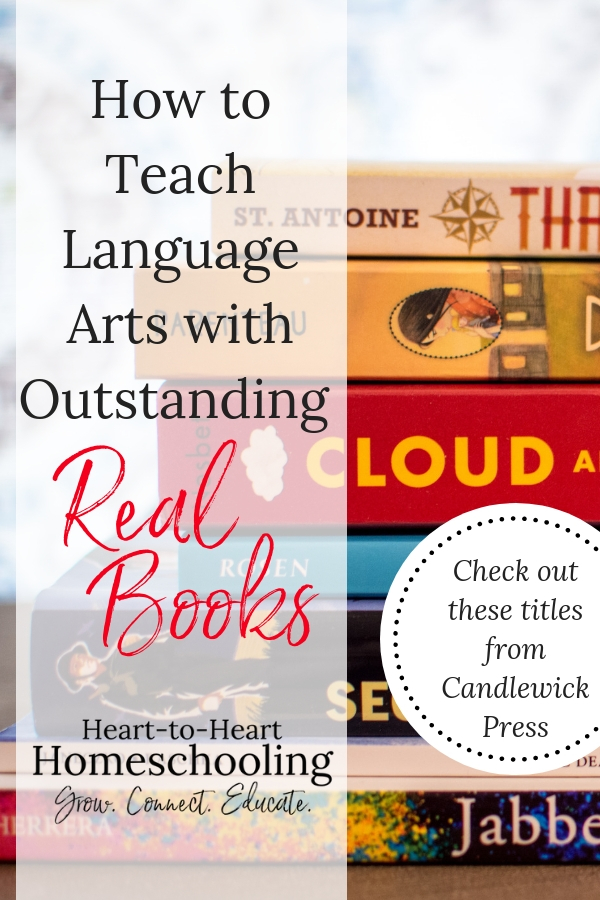
The Power of Homeschooling with Real Books
In the series Teach Language Arts Naturally, I shared how children learn to read and write in much the same way they learn to speak.
You don’t give babies board-book textbooks and worksheets. You simply talk to them. And even when you don’t speak directly to them, they absorb the language around them. They imitate sounds, and then utter their first words. Then their words grow to phrases, the phrases to sentences, and before you know it they are speaking like little adults.
The same is true for reading and writing. We can teach them using real books. We can teach by letting them read, then write; write, then read. So what you really need to teach Language Arts is a selection of good books. Of real books.
What are real books (also referred to as living books)?
These are books written by one author. In the case of poetry it might be an anthology, but the poems are by poets—not textbook authors hired with the purpose of writing poetry.
Authors know their subjects and craft their words with intention. They use literary devices, description, characterization, setting and all the things that make a real book engaging.
How to Teach Language Arts with Real Books from Candlewick Press
I received these books at no cost in exchange for an honest review and host the giveaway. A positive review was not required.
Candlewick Press has a huge selection of non-fiction and fiction books perfect for teaching Language Arts in your homeschool. The following selections works well for teaching the middle grades, approximately 6th through 8th.
Teach Poetry and More in Your Homeschool
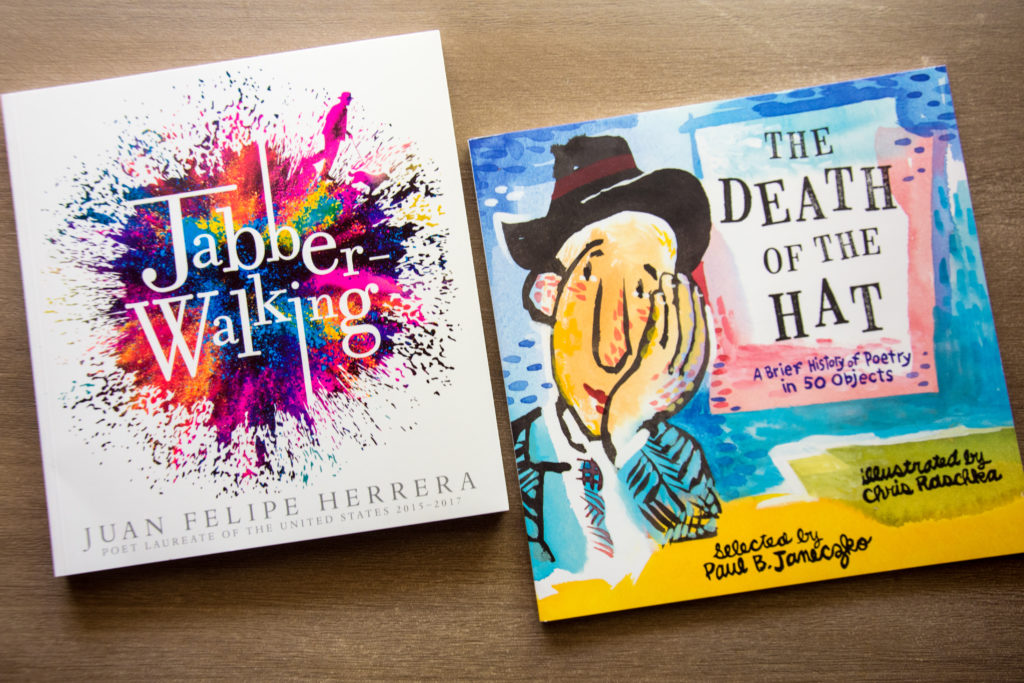
Why is it that we as homeschool moms often shy away from teaching poetry? I think it is because we think we have to teach it. And our own memories of analyzing and dissecting poems leaves us a bit hesitant.
Before you do all those things (meaning wait for a while!), help your children to learn to simply enjoy it. To appreciate the musical language, the images—the whimsical and the serious. Capture their imaginations first. And know it is OK for them to not understand it all from the beginning!
Jabberwalking

Can I admit something? At first when I began flipping through this book I wasn’t sure what to think of it. It was so…different. Different from a traditional anthology of poems. Different in look and feel and intent.
But different is good.
Juan Felipe Herrera, the Poet Laureate of the United States (2015-2017) wrote Jabberwalking as an invitation. An invitation to walk and write. To observe. To hear and see while moving and writing and recording. And to do it fast. It’s an invitation not just to read poetry, but to create it.
It reminds me of the idea of freewriting. Freewriting is a way for us to simply get words out, to see where they take us, without thinking about the exact form. Without questioning or editing as we go. Writers set a timer and just write, not lifting their pen from the page, not judging what they have written. It’s about not worrying about the rules of writing so you can actually write.
You’ll notice from the picture, Jabberwalking isn’t about following a certain form or pattern of poetry. Instead of the format determining the words, the opposite is true. The words determine the format. And the “Jabber Notebook” gives you insight into the author’s own life. Glimpses into his personal journal.
How you can use Jabberwalking to teach Language Arts in Your Homeschool
- Before even opening the book, ask your students what might have inspired the name for it. (Hint: It’s a famous poem by Lewis Carroll 😉) Then read the poem!
- Notice the poet’s choice of vocabulary. It isn’t always the “traditional” choice. Ask them: Why do you think that is? How does the choice of certain words affect you as a reader? How would this freedom to create words and sounds affect your own writing?
- Talk about the author’s style. Ask your children: How does the writing affect how you read the poetry? Read it out loud. Let the words determine your pace, your volume, and what to emphasize.
- Then go jabberwalking together. Pen and journal in hand…walk and write. Phrases, thoughts, feelings.
The Death of the Hat: A Brief History of Poetry in 50 Objects
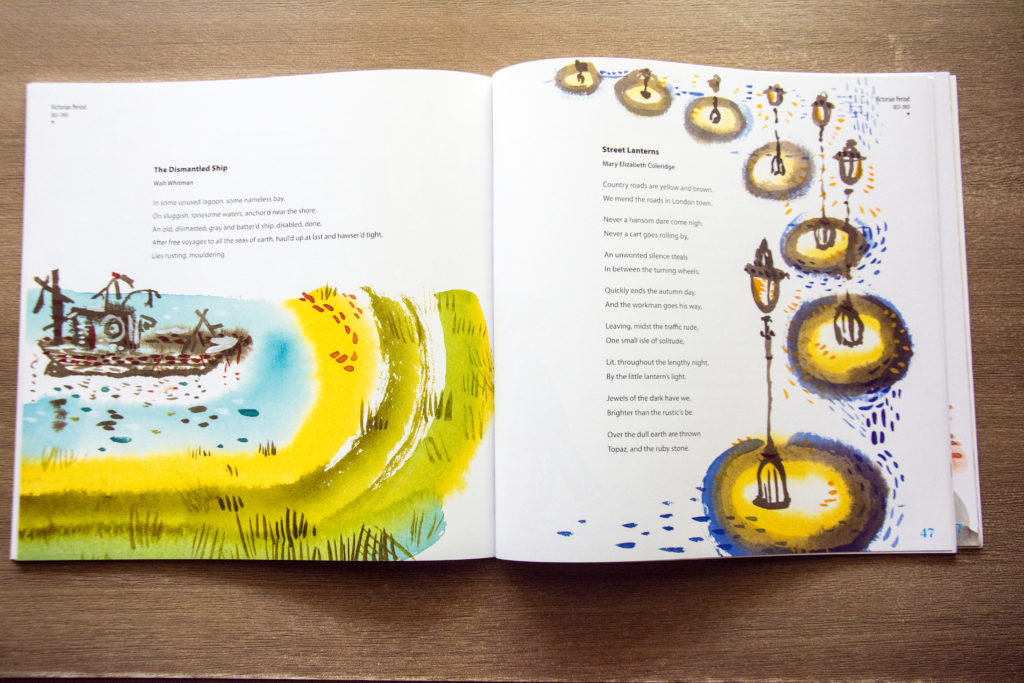
The poems of The Death of the Hat: A Brief History of Poetry in 50 Object were selected by Paul B. Janeczko. And Chris Raschka illustrated it. And just a side note—when we see learning as connected instead of separate subjects we will stop and notice. The illustrations in this book are truly beautiful works of art. And the poems mixed with the watercolor illustrations are magical.
How you can use The Death of the Hat to teach Language Arts in Your Homeschool
- Use the tips on the front inside cover explaining how to recite poetry. Go over them and have each child choose a poem to share.
- Connect art and language. Have your students look at an illustration and tell you what they think the poem will be about based on it before they read. Then do the opposite with another poem. Read it aloud, and then show them the illustration. Ask: Did the illustration match what you imagined? What picture came to your mind. Or have them use watercolors and paint their own illustration before looking at the book.
- Have students choose a poem to pattern one of their own after. Let them write and illustrate it. This can be an ongoing project over the year, so that in the end they will have a collection of their own work.
- Learn about poetic devices and do a scavenger hunt. List some of the different devices on a sheet of paper. When your children find an example, have them write the page number where it is found next to the name of the device. When they are finished, let them share their favorites with one another.
One of the things I like about Death of the Hat is that it doesn’t fit nicely in one category of books. Yes, it is a poetry anthology, but it is also about history. And as we noted earlier, even art. I believe real learning goes beyond memorizing facts and gaining knowledge. It is about making connections. About seeing things in a new way.
So you can also use this book alongside your history studies. What poems were being written during the time you are studying? How did the poems reflect the predominate worldview of the times? The introduction has historical information on each team period to get you started.
And speaking of history connections…
Teach with Biographies in Your Homeschool
My oldest son is a history major in college now. His love for history began in Kindergarten. And I have no doubt that a lot of that love developed as he read historical novels and biographies.
Both of which Candlewick offers for your homeschool student.
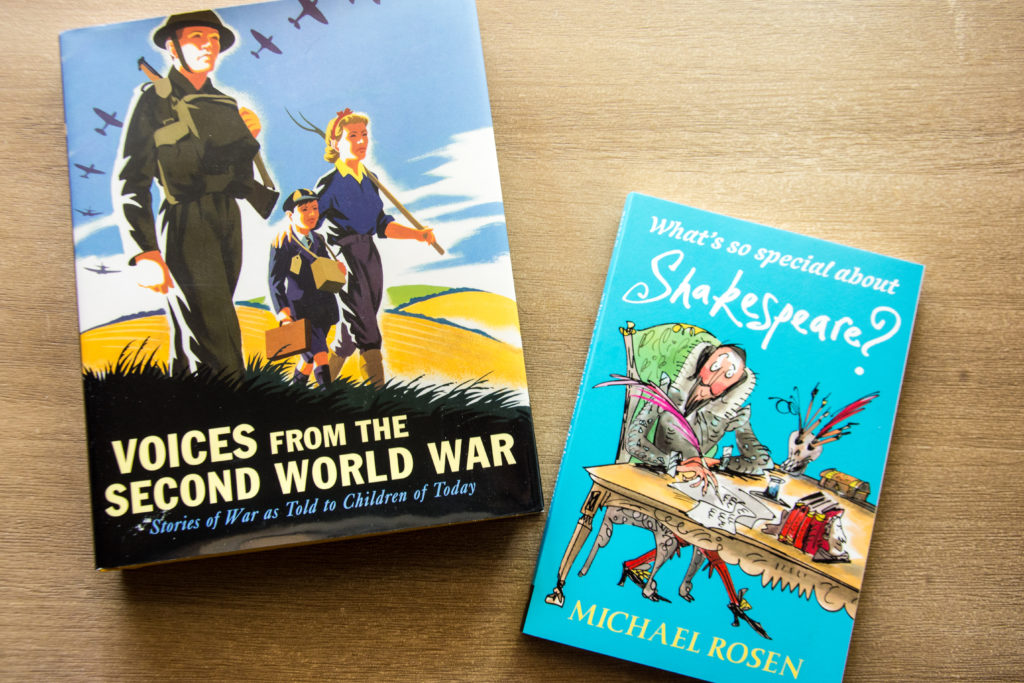
Voices From the Second World War
Voices from the Second World War: Stories of War as Told to Children of Today is a collection of stories as told to children all over the world about the experiences of various people during the Second World War.
Filled with photographs, this book helps children understand a time in our history through the eyes of those who lived through it. As that generation passes away, we are left with the treasure of their stories.
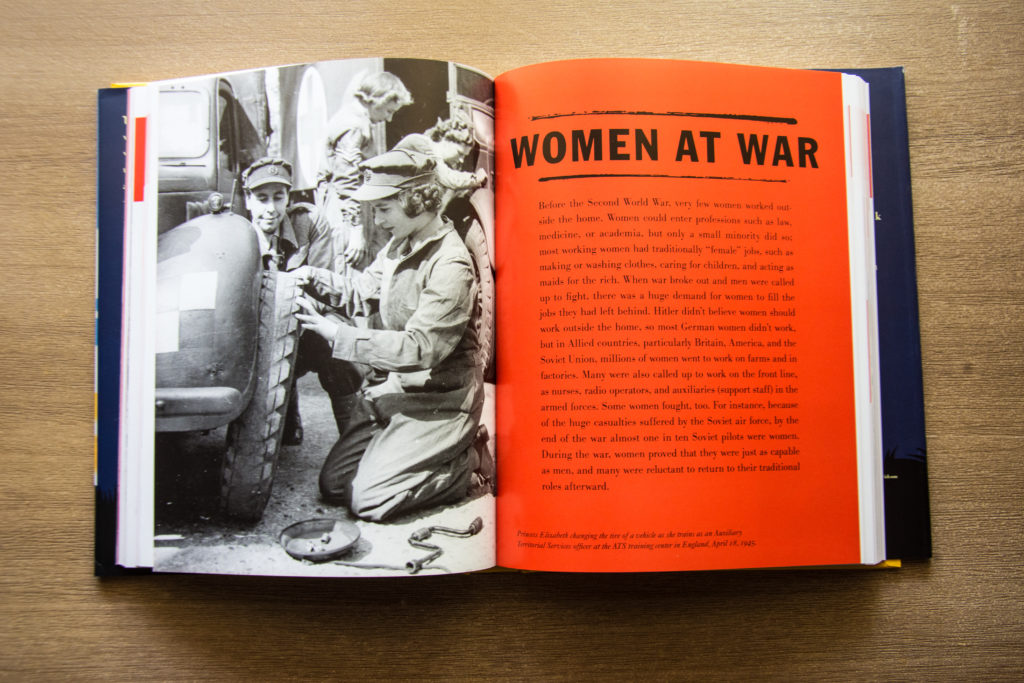
How you can use Voices from the Second World War to teach Language Arts in Your Homeschool
- Have your students read some of the stories. Then ask them: What did you find most interesting in each? What did you want to know more about? What is something you didn’t know about that time, that you learned about through their stories? When you are finished discussing these things, ask them to write their own story down. It doesn’t have to be long or “exciting.” Just share what the world is like from their perspective.
- Talk about what 1st person point-of-view versus 3rd person point-of-view is. Have your students choose one or two paragraphs from the account of a person and change it by writing from the 3rd person point of view. Then discuss: Why is writing from the 1st person point-of-view powerful? How did changing it to the 3rd person affect it? How do we know what point of view we should use in our own writing?
- Do you know someone who lived during the time of WWII? Have your children interview them. If you don’t know anyone, see if they can simply interview an elderly person about their life. Then have them write down their stories. This is a great way for kids to connect to grandparents or another significant older person in their lives.
What’s So Special About Shakespeare?
Were you intimidated when you first read Shakespeare? Did you read a few lines and think, “What???” You can make Shakespeare accessible to your children so that when they read the actual works later on, they will have a framework within which to view it.
And hopefully recognize the incredible impact Shakespeare still has on our culture today.

What’s So Special About Shakespeare? by Michael Rosen is both biography and history. Rosen highlights some lesser known facts about Shakespeare and even gives a glimpse into how historians figure out information on people from long ago.
The illustrations by Sarah Naylor are in pen & ink and should appeal to middle-grade students. Actually, they remind of the drawings some fill their notebooks with at that age. You can encourage your own child to draw pictures in a similar style.
How you can use What’s So Special About Shakespeare? to teach Language Arts in Your Homeschool
- Explore some of Shakespeare’s poetry. Have them find out what a sonnet is, and encourage them to write their own.
- Let your students pick one thing they read about such as the Globe Theater, London during those times, or any topic that caught their interest. Have them do more research and write their own “chapter” to this book expanding on it.
- Read one of Shakespeare’s plays in story form. Mary Lamb’s Tales from Shakespeare is a public domain work and can be found free for a Kindle reader. By reading a play in story form first, students don’t tend to be as intimidated when it comes to reading the actual play. Their familiarity with the story will help them to get used to the difference in language.
- Act out a scene from one of the plays with friends. Let your students work with other kids to put on a scene from a Shakespeare play. Encourage them to make costumes and put on a performance.
Teach with Fiction in Your Homeschool
Using real books was the cornerstone of our Language Arts curriculum. You can use any of these books for copywork, dictation, narration, or as a read aloud.

Fiction gives us the opportunity to step into the lives of other people—those who are different than us. Yes, they aren’t technically “real” people. But characters are built on the beliefs, actions, and thoughts of people all over the world.
Reading fiction helps us to view life through a different lens, to consider how someone else might feel or see the world. And sometimes we meet a character that is just like us, and we don’t feel like “I must be the only one.”
Cloud and Wallfish
In Cloud and Wallfish, Anne Nesbet seamlessly and creatively combines fiction and non-fiction in a compelling and memorable way. While historical facts are woven throughout the story, the “Secret Files” highlight significant ones. Though fiction, the reader has a picture of a time not so long ago. A time many of us as parents even remember. There is so much I could share about this book, but the beauty is in the unfolding of the story. I encourage you to read this one together.
How you can use Cloud and Wallfish to teach Language Arts in Your Homeschool
- Learn more about the Iron Curtain and the Berlin Wall. Research the history of this time period. Have your students write their own “secret file”.
- Read What is a Narrator and talk about how it relates to the narrator in this book. What point of view is the story told from? How does the author use the narrator in a unique way? What do we know because of the narrator?
- Talk about Noah’s stuttering and the impact it had on his life. How did he view it? How did others view it? What did writing do for Noah? Writing is a way all of us can express ourselves. It helps us to clarify our thoughts. Writing is thinking. Encourage your children to keep a journal and write in it several times a week.
Dolls of Hope
Dolls of Hope by Shirley Parenteau is the kind of books that takes us in and helps us to look at another culture in another time. There are connections between geography and history. The story is based on a real event—the Friendship Doll Exchange in 1927, an event that many of us are unaware of. This book is follows another by the same author, Ship of Dolls, although it can stand alone.
How you can use Dolls of Hope to teach Language Arts in Your Homeschool
Dolls of Hope is filled with dialogue, so use it to teach your students how to write their own.
- In a reference book or online, look up the rules for punctuating dialogue together. See if you can find examples of the different rules in your book.
- Have students do copywork or dictation from passages that include dialogue.
- Make up your own dialogue. Read a familiar fairy tale or children’s story. Then have your students choose two characters and a scene from the story. Let them write the dialogue between the two characters. Or have two of your kids work together, each taking on the role of one of the characters and coming up with their dialogue together.
Three Bird Summer
The middle school years are a time of transition—sometimes they feel awkward, sometimes embarrassing. That is why a classic coming-of-age story resonates with students in the middle grades.
Three Bird Summer by Sara St. Antoine is one of those books. It is about transitions, and what it looks like to navigate change. This is a book exemplifying the best of characterization by an author. Funny at times, Three Bird Summer feels a bit like a lazy day in a canoe (in the best possible way), the story unfolding slowly.
It takes time to get to know someone after all.
How you can use Three Bird Summer to teach Language Arts in Your Homeschool
Three Bird Summer is all about character development, so use it to teach your students about characterization.
- In a reference book or online, find out what characterization is and the differences between direct and indirect characterization.
- Learn the difference between dynamic and static characters? What category would you place each of the major characters in and why?
- Discuss the following questions with your students: What are some examples of direct characterization in Three Bird Summer? Where some examples of indirect characterization? Which do you think is better? Why?
- Draw a picture of each of the major characters in this book based on what you learned about them.
- Create your own character. Once again, read a familiar fairy tale or children’s story. Have your students create a new character for the story. Read 5 Tips for Creating Characters for Kids to help.
Using Real Books in Your Homeschool
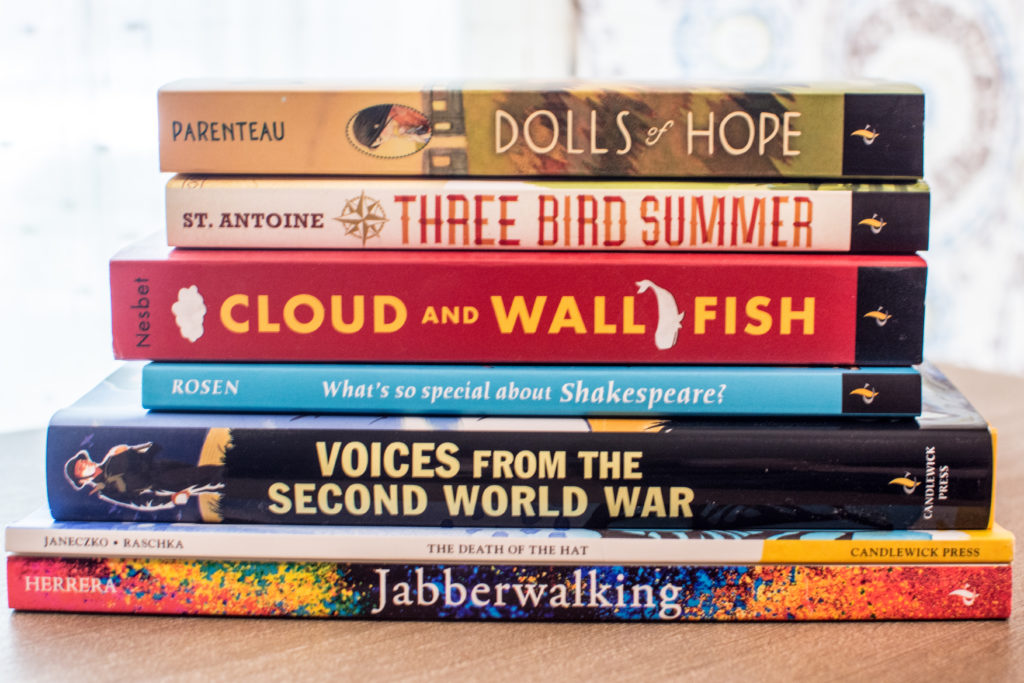
As homeschoolers, we all come to literature with different standards about what we feel our kids should be reading. About when they are mature enough to handle certain topics.
Some of the topics in these books are tough—a world war, living behind the Berlin Wall, watching grandparents as they grow older. But navigating tough subjects through literature is actually one of the things I liked about using real books in our homeschool. It gave us a safe place to explore difficult things.
If you are hesitant about allowing your kids to read certain books, then simply consider reading them aloud to your children and experience the stories together.
But by using these real books, you will teach kids not just Language Arts skills. You will help them learn about history, develop an appreciation for beauty in language and art, and see the connections in the books they read.
And they never even need to read or open textbook.
Candlewick Press has a social offer for you:
Order from the Candlewick Press site and save 25% with discount code CANDLEWICK at checkout.
A Giveaway!
Sorry! THE GIVEAWAY HAS ENDED
Candlewick is giving 30 winners the first book in the Judy Moody series. It is open to US and Canada residents. Closing Date: 4/18/2018 11:00 pm EST. Enter today!
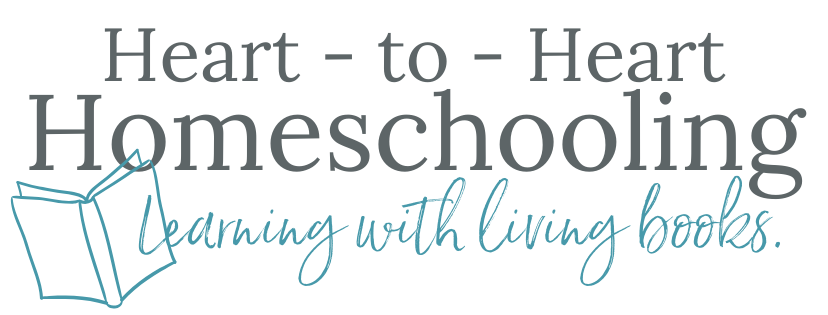
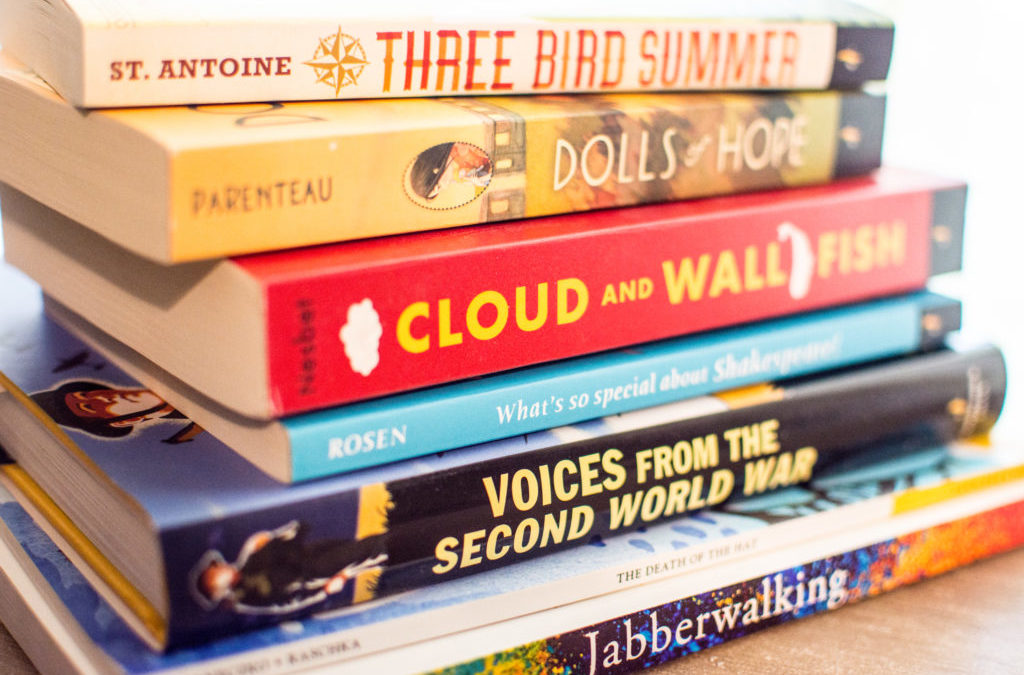

Love love this post! Wow! Packed full of useful information to easily adapt in our homeschools. And so well written!
Thanks Courtney 🙂